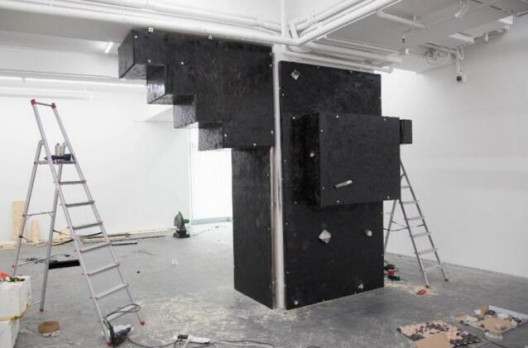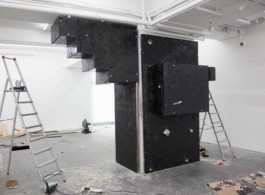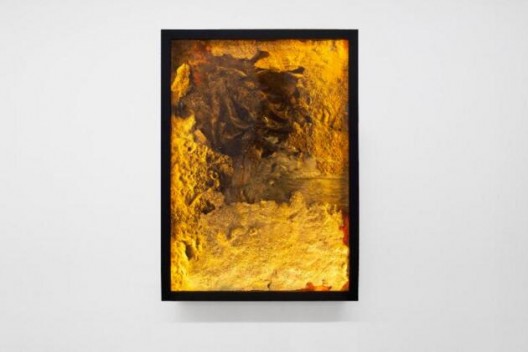“PRACTICE”
DE SARTHE GALLERY
DE SARTHE GALLERY is pleased to announce PRACTICE, a solo exhibition by Andrew Luk (b.1988) concluding the inaugural de Sarthe Artist Residency (deSAR). Opening 2 September, the show features all new work and explores themes of violence, entropy, preservation, and the relationship between civilization and nature, as well as the dynamics of the gallery residency itself.
Luk uses homemade napalm-an incendiary agent that’s wartime use been banned by the United Nations-in his Horizon Scan series to torch and char painted canvas. The burned remains are carefully collaged together, submerged in resin and painstakingly polished for several days to produce the final work. When installed, the piece is lit from within, illuminating an unfamiliar landscape that exists outside of the wall it rests upon. As minutes pass, the layers appear to shift and slide as the lights change, revealing nuances and subtleties in the mutable patterns; this is a direct reference to Luk’s view of time, which he manipulates by reconfiguring fictional and factual material histories and composing arrangements that blur the lines between the manmade and the naturally occurring. Additionally, the violent material and actions used to create the series reflect upon the real-world landscapes we all live amongst, which, despite their beauty, are often formed by stories of conflict.
Distilled of Fired Leaves is series of work where Luk has carefully burnt and transformed the fronts of air conditioning units into effigies of preserved decay. His meticulous process yields textures and forms that appear natural, like snakeskin, ridgelines, and fungal growth. Through the stark juxtaposition of these textures against the history and use of plastic a/c units, Luk further exposes a grey area between man-made and natural, calling into question our assumed notions of this apparent dichotomy.

In Catalyst Kit Luk challenges the transition of art from studio to gallery by using bubble wrap as a point of departure. To produce the series, Luk first made a silicon mold of a painting covered in bubble wrap and then layer by layer, he poured soft resin into the mold. Simultaneously, he arranged together a potpourri of objects from his studio in the resin. This process and its final result solidify and eternalize the daily objects that are often sources of inspiration within the artist’s studio space. Catalyst Kit serves as a metaphor of the residency program itself, reversing the usual positions of private and public in the creation of art and its presentation.
Luk’s Excavator takes the form of a video that captures the unseen environment beneath the gallery’s raised floor. The artist attaches a Xiaomi camera to a remote control car and navigates througha labyrinth of non-space, while the camera documents everything it encounters. This includes remnants of the space’s previous functions such as drywall, cigarette butts, chip bags, and power cords. Via the resultant video Luk crafts a comment on the virtual techniques that have transformed our relationship and understanding of not only space, but also landscape. The miniaturized drone uncovers the history of the gallery space, while its large, more sophisticated counterparts capture the entire surface of the earth, or search and destroy living targets. His micro investigation of a macro phenomenon illuminates the emotional and logical distance between our understanding of an location when it is limited to the eyes of drone.
The largest work in the show, Black Square Problem Setting is a functional climbing wall built around one of the columns in the gallery. Luk used non-traditional materials such as iron pipes, wooden boards and casts of found objects to create the installation. Black Square Problem Setting interrupts the discomfort of a hygienic gallery space with an impulsive, yet athletic creativity that the art world conventionally regards as unsophisticated. By invading the space with sweaty, filthy, but friendly climbers, the piece is designed to push artfolk up against the walls of their own spaces and address the condescension and dogmatic narrow-mindedness with which art is often presented. The use of “Black Square” in the title refers to Kazimir Malevich’s (1878-1935) “Black Square” which was painted with the intent of grasping the ultimate zero-a revolutionary banner for no one. Within Luk’s installation, the large black form gives the impression of a flat surface, ambiguous in its definition. However, as more climbers take to the structure, the accumulated hand and foot holds, as well as chalk dust build up on its surface. This gives the work an accurate sense of its actual form, addressing a dependence on people at large applying value and personal experience to art, even if at times it seems to exist in a hermetic space.




